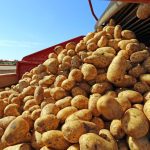A new analysis of 450 genomes from cultivated potatoes and 56 genomes of wild potato species has revealed that the potato lineage originated through natural interbreeding between a wild tomato plant and a potato-like species in South America about 9 million years ago.

Evolutionary origins of the potato revealed – and a tomato was involved
Study, which analyzed genomes from cultivated and wild potatoes, may improve future breeding

In one giant leap for Earth plants, seeds are grown in moon soil
Washington | Reuters — Scientists for the first time have grown seeds in soil from the moon — samples retrieved during NASA missions in 1969 and 1972 — in an achievement that heralds the promise of using earthly plants to support human outposts on other worlds. Researchers said on Thursday they planted seeds of a

Locust swarming pheromone identified in step toward curbing plagues
Washington | Reuters — Scientists have identified a chemical compound released by locusts that causes them to swarm, opening the door to possible new ways to prevent these insects from devouring crops vital to human sustenance as they have for millennia. Researchers said on Wednesday they identified the pheromone — that is, a chemical produced

U.S. regulators allow GM cotton as human food source
Washington | Reuters — U.S. regulators on Friday gave the green light for genetically modified cotton to be used for human consumption, paving the way for a protein-packed new food source — edible cottonseed that tastes a bit like chickpeas — that its developers said could help tackle global malnutrition. The Food and Drug Administration’s

World’s oldest bread found at prehistoric site in Jordan
Washington | Reuters — Charred remains of a flatbread baked about 14,500 years ago in a stone fireplace at a site in northeastern Jordan have given researchers a delectable surprise: people began making bread, a vital staple food, millennia before they developed agriculture. No matter how you slice it, the discovery detailed on Monday shows

Genetic study may make ancient Inca’s quinoa a grain of the future
The findings could pave the way to breeding out the bitter saponins that must currently be washed off post-harvest
Quinoa, the sacred “mother grain” of the ancient Inca civilization suppressed by Spanish conquistadors, could become an increasingly important food source in the future thanks to genetic secrets revealed in a new study. Scientists on Feb. 7 said they have mapped the genome of quinoa and identified a gene that could be manipulated to get

Scientists peel back carrot’s genetic secrets
Reuters — Scientists have gotten to the root of the carrot, genetically speaking. Researchers said Monday they have sequenced the genome of the carrot, an increasingly important root crop worldwide, identifying genes responsible for traits including the vegetable’s abundance of vitamin A, an important nutrient for vision. The genome may point to ways to improve

Wild bees seen dwindling in main U.S. crop regions
Washington | Reuters — Wild bees, crucial pollinators for many crops, are on the decline in some of the main agricultural regions of the U.S., according to scientists who produced the first national map of bee populations and identified numerous trouble spots. The researchers on Monday cited 139 counties as especially worrisome, with wild bee

Unlocking pineapple’s genetic secrets
Engineering crops like wheat to use the pineapple’s method of photosynthesis could dramatically boost its drought tolerance
The pineapple, the tropical fruit enjoyed by people worldwide in slices, chunks, juice, upside-down cakes, piña coladas, glazed ham and pizza, is finally giving up its genetic secrets. Scientists say they have sequenced the genome of the pineapple, learning about the genetic underpinning of the plant’s drought tolerance and special form of photosynthesis. The genome

Rising CO2 levels may cut nutrient levels in crops, study finds
Wheat and rice were lower in zinc, iron and protein at higher levels of CO2
Rising levels of carbon dioxide in the atmosphere may cut the nutritional quality of some of the world’s most important food crops, researchers reported May 7 after conducting experiments simulating conditions expected by mid-century. The amounts of two important nutrients, zinc and iron, were found to be lower in wheat, rice, soybeans and field peas

